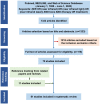NIR light-assisted phototherapies for bone-related diseases and bone tissue regeneration: A systematic review
- PMID: 33052249
- PMCID: PMC7546009
- DOI: 10.7150/thno.49784
NIR light-assisted phototherapies for bone-related diseases and bone tissue regeneration: A systematic review
Abstract
Recently, the rapid development of biomaterials has induced great interest in the precisely targeted treatment of bone-related diseases, including bone cancers, infections, and inflammation. Realizing noninvasive therapeutic effects, as well as improving bone tissue regeneration, is essential for the success of bone‑related disease therapies. In recent years, researchers have focused on the development of stimuli-responsive strategies to treat bone-related diseases and to realize bone regeneration. Among the various external stimuli for targeted therapy, near infrared (NIR) light has attracted considerable interests due to its high tissue penetration capacity, minimal damage toward normal tissues, and easy remote control properties. The main objective of this systematic review was to reveal the current applications of NIR light-assisted phototherapy for bone-related disease treatment and bone tissue regeneration. Database collection was completed by June 1, 2020, and a total of 81 relevant studies were finally included. We outlined the various therapeutic applications of photothermal, photodynamic and photobiomodulation effects under NIR light irradiation for bone‑related disease treatment and bone regeneration, based on the retrieved literatures. In addition, the advantages and promising applications of NIR light-responsive drug delivery systems for spatiotemporal-controlled therapy were summarized. These findings have revealed that NIR light-assisted phototherapy plays an important role in bone-related disease treatment and bone tissue regeneration, with significant promise for further biomedical and clinical applications.
Keywords: Near infrared light; bone tissue regeneration; bone-related diseases; drug delivery systems; phototherapy.
© The author(s).
Conflict of interest statement
Competing Interests: The authors have declared that no competing interest exists.
Figures






Similar articles
-
Tumor-targeted and multi-stimuli responsive drug delivery system for near-infrared light induced chemo-phototherapy and photoacoustic tomography.Acta Biomater. 2016 Jul 1;38:129-42. doi: 10.1016/j.actbio.2016.04.024. Epub 2016 Apr 16. Acta Biomater. 2016. PMID: 27090593
-
Advancements in Photothermal Therapy Using Near-Infrared Light for Bone Tumors.Int J Mol Sci. 2024 Apr 9;25(8):4139. doi: 10.3390/ijms25084139. Int J Mol Sci. 2024. PMID: 38673726 Free PMC article. Review.
-
Near-infrared photoresponsive drug delivery nanosystems for cancer photo-chemotherapy.J Nanobiotechnology. 2020 Aug 3;18(1):108. doi: 10.1186/s12951-020-00668-5. J Nanobiotechnology. 2020. PMID: 32746846 Free PMC article. Review.
-
Near-infrared light control of bone regeneration with biodegradable photothermal osteoimplant.Biomaterials. 2019 Feb;193:1-11. doi: 10.1016/j.biomaterials.2018.12.008. Epub 2018 Dec 10. Biomaterials. 2019. PMID: 30550998
-
Dynamic-Covalent Hydrogel with NIR-Triggered Drug Delivery for Localized Chemo-Photothermal Combination Therapy.Biomacromolecules. 2020 Feb 10;21(2):556-565. doi: 10.1021/acs.biomac.9b01290. Epub 2019 Dec 12. Biomacromolecules. 2020. PMID: 31804804
Cited by
-
Exploration of Site-Specific Drug Targeting-A Review on EPR-, Stimuli-, Chemical-, and Receptor-Based Approaches as Potential Drug Targeting Methods in Cancer Treatment.J Oncol. 2022 Sep 29;2022:9396760. doi: 10.1155/2022/9396760. eCollection 2022. J Oncol. 2022. PMID: 36284633 Free PMC article. Review.
-
Reprogramming Lung Redox Homeostasis by NIR Driven Ultra-Small Pd Loaded Covalent Organic Framework Inhibits NF-κB Pathway for Acute Lung Injury Immunotherapy.Adv Sci (Weinh). 2025 Apr;12(14):e2413697. doi: 10.1002/advs.202413697. Epub 2025 Feb 18. Adv Sci (Weinh). 2025. PMID: 39965148 Free PMC article.
-
Impact of photobiomodulation therapy on pro-inflammation functionality of human peripheral blood mononuclear cells - a preliminary study.Sci Rep. 2024 Oct 4;14(1):23111. doi: 10.1038/s41598-024-74533-y. Sci Rep. 2024. PMID: 39367102 Free PMC article.
-
Phototherapy techniques for the management of musculoskeletal disorders: strategies and recent advances.Biomater Res. 2023 Nov 28;27(1):123. doi: 10.1186/s40824-023-00458-8. Biomater Res. 2023. PMID: 38017585 Free PMC article. Review.
-
Strategies of functionalized GelMA-based bioinks for bone regeneration: Recent advances and future perspectives.Bioact Mater. 2024 May 9;38:346-373. doi: 10.1016/j.bioactmat.2024.04.032. eCollection 2024 Aug. Bioact Mater. 2024. PMID: 38764449 Free PMC article. Review.
References
-
- Shi C, Wu T, He Y, Zhang Y, Fu D. Recent advances in bone-targeted therapy. Pharmacol Ther. 2020;207:107473. - PubMed
-
- Yang Y, Aw J, Xing B. Nanostructures for NIR light-controlled therapies. Nanoscale. 2017;9:3698–718. - PubMed
-
- Zhao W, Zhao Y, Wang Q, Liu T, Sun J, Zhang R. Remote Light-Responsive Nanocarriers for Controlled Drug Delivery: Advances and Perspectives. Small. 2019;15:e1903060. - PubMed
-
- Wan Z, Zhang P, Liu Y, Lv L, Zhou Y. Four-dimensional bioprinting: Current developments and applications in bone tissue engineering. Acta Biomater. 2020;101:26–42. - PubMed
Publication types
MeSH terms
LinkOut - more resources
Full Text Sources
Medical
Miscellaneous

